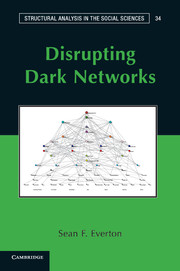Book contents
- Frontmatter
- Contents
- Figures
- Tables
- Preface
- Acknowledgments
- Part I Introduction
- Part II Social Network Analysis: Techniques
- Part III Social Network Analysis: Metrics
- 5 Network Topography
- 6 Cohesion and Clustering
- 7 Centrality, Power, and Prestige
- 8 Brokers, Bridges, and Structural Holes
- 9 Positions, Roles, and Blockmodels
- Part IV Social Network Analysis: Advances
- Part V Conclusion
- Appendix 1 The Noordin Top Terrorist Network
- Appendix 2 Glossary of Terms
- Appendix 3 Multidimensional Scaling with UCINET
- Appendix 4 The Just War Tradition
- References
- Index
6 - Cohesion and Clustering
Published online by Cambridge University Press: 05 April 2013
- Frontmatter
- Contents
- Figures
- Tables
- Preface
- Acknowledgments
- Part I Introduction
- Part II Social Network Analysis: Techniques
- Part III Social Network Analysis: Metrics
- 5 Network Topography
- 6 Cohesion and Clustering
- 7 Centrality, Power, and Prestige
- 8 Brokers, Bridges, and Structural Holes
- 9 Positions, Roles, and Blockmodels
- Part IV Social Network Analysis: Advances
- Part V Conclusion
- Appendix 1 The Noordin Top Terrorist Network
- Appendix 2 Glossary of Terms
- Appendix 3 Multidimensional Scaling with UCINET
- Appendix 4 The Just War Tradition
- References
- Index
Summary
Introduction
A major focus of social network analysis is to identify dense clusters of actors “among whom there are relatively strong, direct, intense, and/or positive ties” (Wasserman and Faust 1994:249). Social network analysts often refer to these clusters of actors as cohesive subgroups and generally assume that “social interaction is the basis for solidarity, shared norms, identity, and collective behavior, so people who interact intensively are likely to consider themselves a social group” (de Nooy, Mrvar, and Batagelj 2005:61). Social network analysts use several approaches for identifying cohesive subgroups. One way is to cluster actors based on attributes (e.g., race, gender), but the more common approach is to focus on the pattern of ties (i.e., relations) among actors. Perhaps not surprisingly, social network analysts have developed a variety of algorithms for identifying subgroups:
Once analysts began to try to formalize the idea of the clique and to devise mathematical measures of the number and cohesion of cliques, it was…recognized that there were a number of different ways of operationalizing the apparently simple idea of the “clique”: for example, cliques could be seen as groups of mutually connected individuals or as pockets of high density. Thus, a number of different theoretical models of subgroups emerged, variously described as “cliques,” “clusters,” “components,” “cores,” and “circles.” Apart from beginning with the letter “c,” these concepts have very little in common with one another. (Scott 2000:100)
This chapter explores some (but not all) of the various approaches for using patterns of ties for identifying cohesive subgroups within social networks. Specifically, it examines components, cores, factions, and Newman groups. It does not consider perhaps the strictest algorithm for identifying subnetworks, namely, “cliques,” which are defined as a subset of actors wherein each actor is directly connected to all other actors (in other words, the density of a clique is 100 percent). Cliques are not considered for two reasons: One is because the assumption that each member of a subgroup has a tie to every other member is probably unreasonable. The second is that actors in a network can belong to more than one clique, which makes identifying distinct subgroups often impossible. We briefly mention the algorithm here, though, because as we will see further on, ORA uses a count of the number of cliques to which an actor belongs as a proxy of that actor's centrality.
- Type
- Chapter
- Information
- Disrupting Dark Networks , pp. 170 - 205Publisher: Cambridge University PressPrint publication year: 2012



